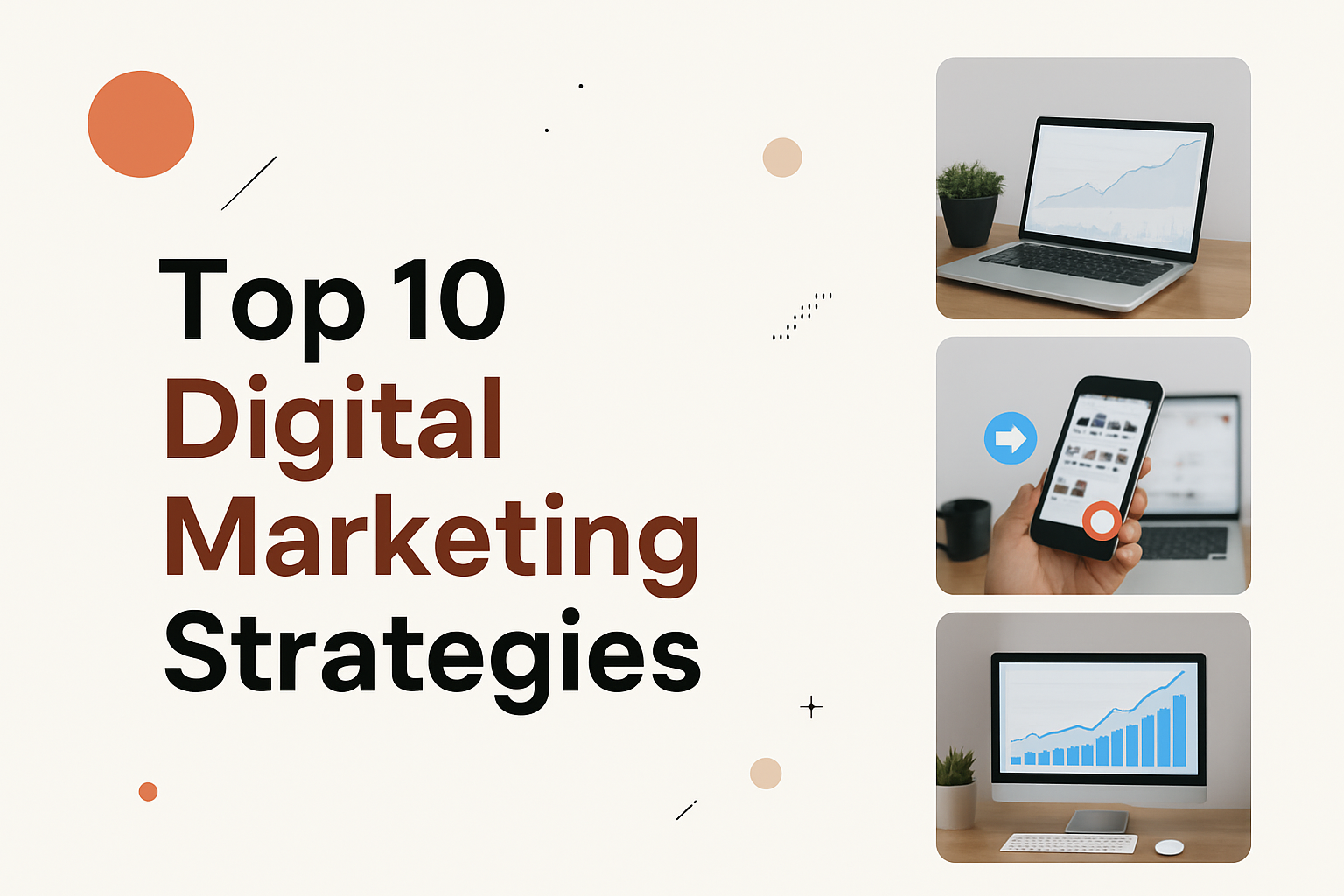Introduction
In today’s fast-paced digital world, marketing is no longer optional — it’s essential. Small businesses, in particular, need smart and cost-effective ways to compete with larger brands and connect with customers. The internet provides endless opportunities, but without a clear strategy, even the best products can remain unseen.
Digital marketing allows small businesses to reach the right audience, build trust, and grow without huge budgets. From social media to SEO, every method plays a vital role in establishing your brand online. Let’s explore ten powerful digital marketing strategies that can help your small business stand out and succeed in 2025.
Social Media Marketing
Social media is the backbone of modern marketing. Platforms like Facebook, Instagram, TikTok, and LinkedIn allow you to connect directly with your target audience. For small businesses, it’s a low-cost way to showcase products, share stories, and engage customers.
The key is consistency and authenticity. Don’t just post promotions — share useful content, customer testimonials, and behind-the-scenes moments. Build a personality for your brand that people can relate to. Engage through comments, polls, and live sessions to create genuine relationships with followers.
Social media marketing isn’t about selling first — it’s about connecting first. Once people trust you, sales follow naturally.
SEO Basics
Search Engine Optimization (SEO) ensures that when people search online for your products or services, your business shows up first. Good SEO helps attract free, organic traffic that converts better than paid ads.
Focus on the fundamentals: keyword research, optimized content, and mobile-friendly website design. Your website should load fast, provide valuable information, and include local keywords if you serve a specific area.
Regularly update your blog or service pages with relevant content. Google rewards websites that stay active and helpful. SEO takes time, but once it kicks in, it becomes a continuous source of leads and visibility.
Email Campaigns
Email marketing remains one of the most effective ways to nurture leads and maintain customer relationships. Unlike social media, where algorithms control visibility, emails land directly in your audience’s inbox.
Build a list of interested subscribers through your website or social media channels. Send regular newsletters with updates, offers, and useful insights. Personalization matters — address subscribers by name and tailor messages to their interests or purchase behavior.
For best results:
-
Keep It Simple: Short, engaging subject lines attract higher open rates.
-
Add Value: Every email should teach, help, or reward the reader.
When done right, email marketing strengthens trust and encourages repeat sales over time.
Content Marketing
Content is the heart of digital marketing. Whether it’s blogs, videos, podcasts, or infographics, quality content establishes authority and draws attention to your brand.
Create content that solves real problems your audience faces. For example, a bakery might share “5 Easy Cake Decorating Tips,” while a fitness coach could post “Quick Morning Workouts for Busy Professionals.” Educational and entertaining content builds loyalty and boosts search visibility.
Consistency and originality make your content marketing successful. Publish regularly and maintain your brand’s voice across every channel.
Paid Ads
Paid advertising is a fast-track method to gain visibility and attract new customers. Platforms like Google Ads, Meta Ads, and TikTok Ads allow you to target specific demographics, locations, and interests.
However, effective ad campaigns require strategy. Start with small budgets, test different ad creatives, and analyze performance. Focus on measurable goals — website visits, signups, or product sales — rather than just clicks.
A strong ad should clearly communicate your value and include a compelling call to action. When used wisely, paid ads can multiply your reach without draining your budget.
Influencer Marketing
Influencer marketing continues to grow, especially for small businesses seeking authentic promotion. Partnering with micro-influencers — creators with smaller but loyal audiences — can drive real engagement.
Choose influencers whose followers match your target audience. Authenticity matters more than numbers. For example, a local fashion brand might collaborate with a regional stylist or lifestyle blogger.
Influencers bring credibility and help introduce your brand to new communities. When managed strategically, influencer partnerships can offer huge returns with relatively low investment.
Video Marketing
Video content is dominating online platforms in 2025. It captures attention faster than text and allows your brand to express personality, creativity, and trust.
Create short, engaging videos that highlight your product benefits, customer stories, or quick tips. Platforms like YouTube Shorts, Instagram Reels, and TikTok make it easy to reach large audiences with simple production tools.
Live streaming can also strengthen relationships by allowing direct interaction with viewers. Video content builds emotional connections — something traditional ads often fail to achieve.
Local SEO and Listings
If your business operates locally, optimizing for local searches is crucial. People searching “near me” or looking for nearby services often make purchasing decisions quickly.
Make sure your business appears on Google Maps, Apple Maps, and online directories. Maintain consistent contact details, address, and operating hours across all platforms.
Encourage happy customers to leave reviews — they boost credibility and ranking. Local SEO ensures that when someone nearby needs your service, your name comes up first.
Automation Tools
Marketing automation saves time and ensures consistency. It allows small businesses to maintain regular engagement without constant manual effort.
Automation tools can help you schedule social media posts, send follow-up emails, track ad results, and even manage customer queries through chatbots. Some popular tools include HubSpot, Buffer, and Mailchimp.
When used effectively:
-
You Save Time: Repetitive tasks are handled automatically.
-
You Stay Consistent: Customers receive timely, personalized messages.
Automation doesn’t replace human creativity — it enhances it by freeing up time for strategy and innovation.
Analytics and Optimization
No digital marketing effort is complete without measurement. Analytics helps you understand what works and what doesn’t. Google Analytics, Meta Insights, and other tools provide valuable data about your traffic, audience behavior, and conversions.
Track key metrics like click-through rates, engagement, and ROI. Regularly analyze your campaigns to identify weak spots and optimize for better performance.
Data-driven decisions turn marketing from guesswork into growth. A business that tracks and adapts will always outperform one that doesn’t.
Conclusion
Digital marketing isn’t a one-time project — it’s an ongoing process of learning, adapting, and connecting. For small businesses, these ten strategies form the foundation of long-term success. From SEO to automation, each method supports the others in building visibility, credibility, and sales.
The secret is consistency. Focus on creating real value for your audience rather than chasing quick results. Over time, the combination of great content, authentic engagement, and smart analytics will make your brand not only visible but unforgettable.
Start small, stay consistent, and keep evolving — your digital presence will soon become your most powerful business asset.


